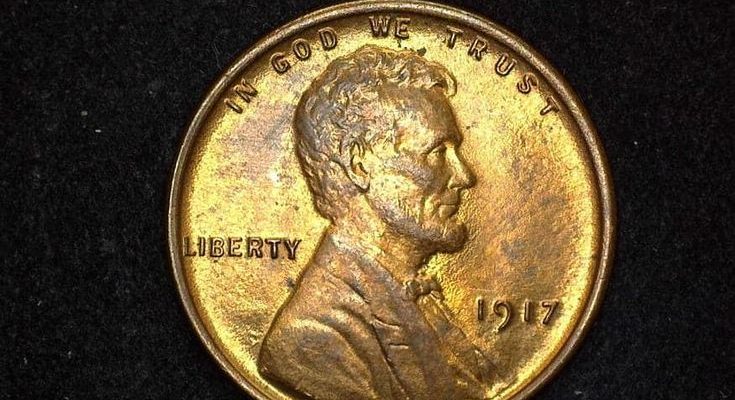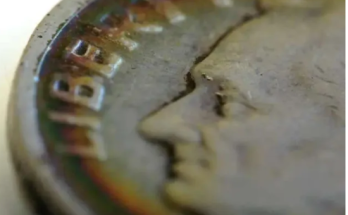Do you have a 1917 Wheat penny? Are you interested in its value?
Table of Contents
The 1917 Wheat penny or Lincoln cent might resemble today’s single-cent coin, but it’s a rare gem. Like other coins in the Wheat penny series, the 1917 penny commemorates the birth of President Abraham Lincoln.
However, it stands out because it was minted when America entered World War 1. As such, it represents a significant piece of American history. This coupled with the sheer age of the coin makes the 1917 penny desirable to collectors.
Now, let’s explore the 1917 Wheat Penny, including its details, value, history, and errors.
1917 Wheat Penny Details
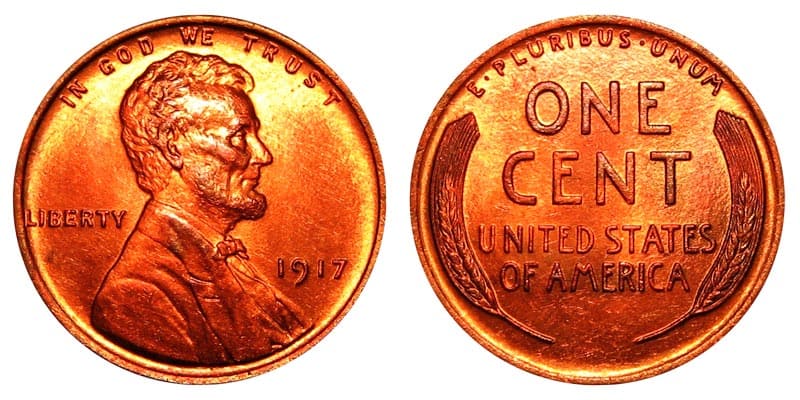
- Category: Lincoln Cents
- Mint: Philadelphia, Denver, and San Francisco
- Mintage: 284,169,785
- Designer: Victor D. Brenner
- Metal Composition: 95% Copper, 5% Tin or Zinc
- Fineness: 95
- Diameter: 19 mm
- Weight: 11 grams
- ASW: 1734oz
- Edge: Plain
The U.S. mint first struck Wheat Pennies in 1909. The coins featured the designer’s (Victor David Brenner) initials, hence the name VDB pennies. However, the initials were deemed too prominent and got removed a few days after release.
After that, the pennies maintained most of their design aspects. The only change between 1916 and 1917 was the production date pressed onto the cent’s obverse side. Another thing, 1917 marked the end of the VDB coins because Brenner’s initials got re-introduced in 1918.
That aside, let’s discuss the features of the coin’s obverse and reverse sides.
The Obverse Side
The 1917 Wheat Penny obverse side shows a portrait of Abraham Lincoln facing right. On top of Lincoln’s head lies the motto “IN GOD WE TRUST”. The lefthand side of the coin bears the word “LIBERTY”. As for the date and mint mark, they fall on the lower right side, below Lincoln’s bow tie.
The Reverse Side
On the reverse side, the penny’s denomination “ONE CENT” and the inscription “UNITED STATES OF AMERICA” fall in the center. Along the right and left sides of the coins lie two sheaves of wheat. Lastly, the Latin phrase “E PLURIBUS UNUM” runs along the top of the coin separated by interpoints.
1917 Wheat Penny: Additional Features
The 1917 Lincoln Wheat Penny was made of 95% copper and 5% zinc and tin. The high copper percentage gave the coins a red sheen. But due to oxidation and exposure to elements, some of the pennies – especially those in circulation – developed a red-brown or brown hue or patina.
Usually, Red (RD) 1917 pennies are rare and highly sought-after by coin enthusiasts. Red and Brown (RB) and Brown (BN) pennies are common and only valuable in pristine conditions or higher grades.
Additionally, the 1917 Wheat Penny weighs only 3.11g (0.10970 ounces) and has a thickness of 1.95 mm (0.07677 inches) and a diameter of 19.05mm (0.75 inches).
Also Read: Top 20 Most Valuable Old Pennies Worth Money (Penny Collection)
1917 Wheat Penny Value Chart
| Mint Mark | Condition | |||
| Good | Fine | Extremely Fine | Uncirculated | |
| 1917 “no mint Mark” Wheat Penny | $0.25 | $0.50 | $7 | $14 |
| 1917 “D” Wheat Penny | $0.75 | $1.75 | $30 | $45 |
| 1917 “S” Wheat Penny | $0.75 | $2 | $17 | $30 |
1917 Wheat Penny Value and Varieties Guide
In 1917, the Philadelphia mint, Denver, and San Francisco struck the Lincoln Wheat Penny. The three facilities minted 284,169,785 wheat pennies. However, it is hard to find mint-state or high-grade pieces today because a majority of the coins entered circulation.
Here, we will explore the different variants of the 1917 Lincoln cents.
1917 “No Mint Mark” Wheat Penny Value
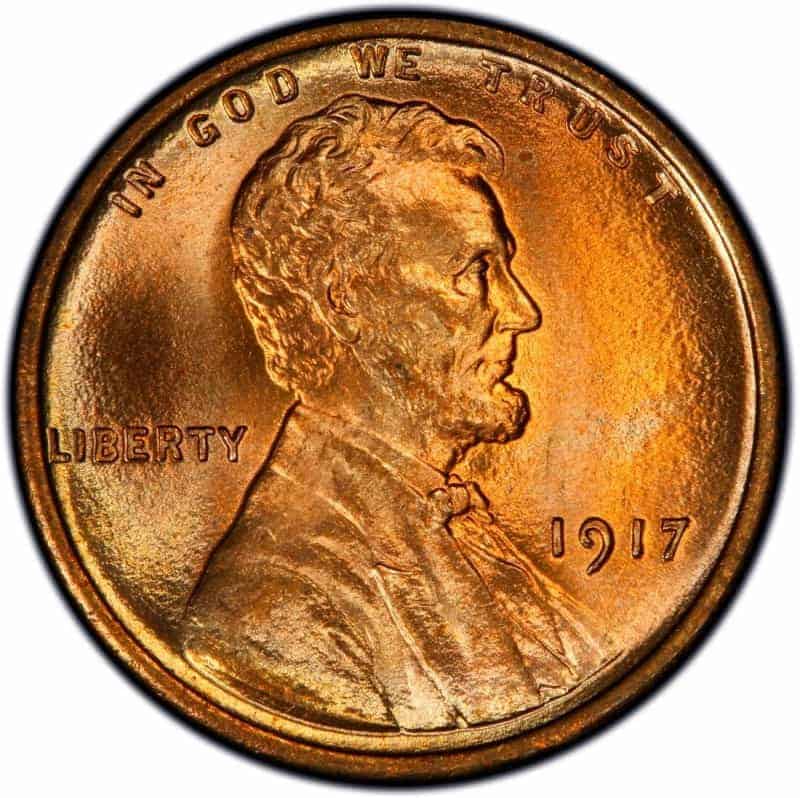
- Type: Wheat Pennies
- Edge: Plain
- Mint Mark: n/a
- Place of Minting: Philadelphia
- Year of Minting: 1917
- Face Value: 1 Cent
- $ Price: $0.25 – $165
- Mintage: 196,429,785
- Designer: Victor D. Brenner
In 1917, the mint in Philadelphia produced over 190 million wheat pennies. These pennies lacked a mint mark because the minting facility began using the “P” mint mark in 1942.
Because of the high mintage, the 1917–no mint mark–Wheat Pennies are super common. As a result, they hold a lower value than their counterparts produced by Denver and San Francisco mints.
Nevertheless, their values vary depending on coloration and condition. Based on coloration, a brown 1917 “no mint mark” wheat penny in mint state 66 or above can cost anywhere from $500 to $1100.
Those in good condition can sell for between $0.25 and $1, while uncirculated pennies can have an estimated value of $14 to $25.
Even though over 19 million 1917 “no mint mark” pennies survived to date, only a few brown coins in grade MS 65 or higher exist.
Red and Brown 1917 “no mint mark” wheat pennies usually have a slightly higher value than Brown pieces. The value of an RB 1917 (no mint mark) Lincoln cent in MS 62 can cost $26. Those at higher grades fetch more prices. In an auction in 2013, an RB 1917 with MS 66 grade sold for $1,293.
About 3000 Red 1917 “no mint mark” exist today, which makes them extremely rare. These pennies have a strong red hue often associated with recently struck coins. An RD 1917 “no mint mark” wheat penny in mint state 65 can sell for as much as $20,000 or more.
1917 “D” Wheat Penny Value
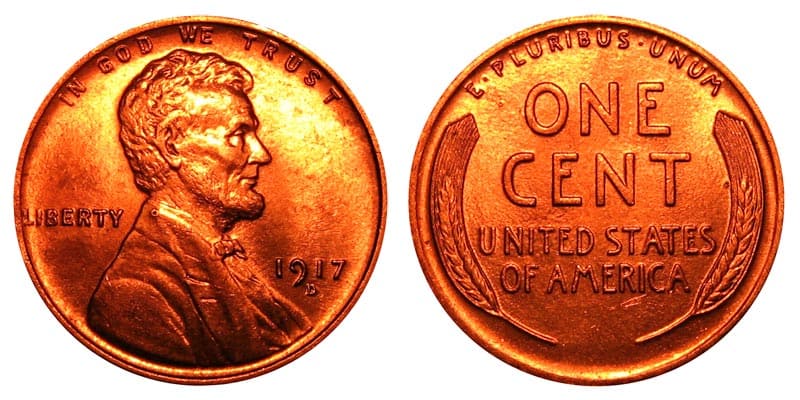
- Type: Wheat Pennies
- Edge: Plain
- Mint Mark: D
- Place of Minting: Denver
- Year of Minting: 1917
- Face Value: 1 Cent
- $ Price: $5 – $1700
- Mintage: 55,120,000
- Designer: Victor D. Brenner
The 1917 “D” Wheat Penny came from the Denver mint. The facility struck over 55 million wheat pennies in 1917.
Although these coins are fewer than those produced by the Philadelphia mint, they suffered some quality issues. The mint in Denver used old and worn-out dies, leading to coins with blurry reverse sides and other errors.
Circulated 1917 “D” Wheat pennies are very common and hold less value, especially in lower grades. Extremely fine and About Uncirculated (AU) coins, free from damage or corrosion are hard to find. If you are lucky to find one in pristine condition, expect its value to range from $30 to $55.
In mint state, BN 1917 “D” Wheat pennies have a value ranging from $100 to $2,750 (MS 66 +). RB pennies at MS 62 and M66 can sell for $185 and $2,800, respectively.
The RD 1917 “D” Lincoln penny is one of the rarest collector’s items and can be valued between $100 to $40,500, depending on the MS grade.
1917 “S” Wheat Penny Value
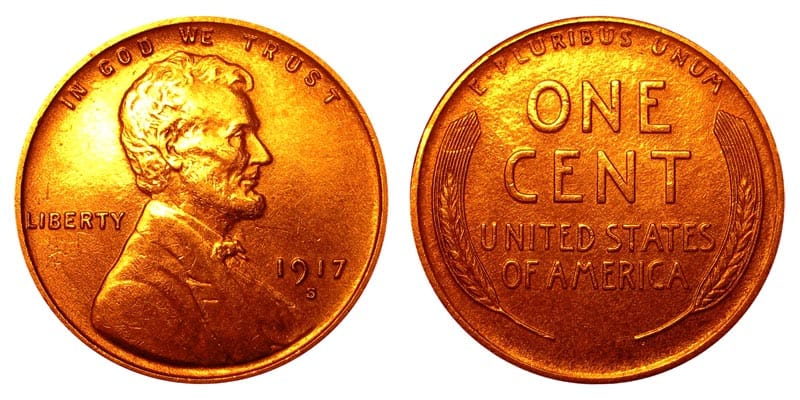
- Type: Wheat Pennies
- Edge: Plain
- Mint Mark: S
- Place of Minting: San Francisco
- Year of Minting: 1917
- Face Value: 1 Cent
- $ Price: $0.75 – $2100
- Mintage: 32,620,000
- Designer: Victor D. Brenner
In 1917, the production of Wheat pennies at the San Francisco mint rose significantly. The facility produced over 32 million wheat pennies with an “S” mint mark.
Because numismatists pursued the S-mint coins for decades, moderately worn specimens of the 1917 “S” Wheat pennies are common, unlike their Denver counterparts. The same applies to Brown (BN) and Red and Brown (RB) mint state 1917 “s” Lincoln cents. But mint state red pennies are quite rare and highly sought out.
As for penny value, a BN 1917 “S” penny in mint state 65 or above can sell for over $9,000. RB 1917 “S” specimens in MS 60 and higher have a value ranging from $135 to$3,600.
RD wheat pennies from San Francisco have an estimated value of $360 at MS 62 and about $80,000 at MS 66. In fact, a 1916 “S” Wheat penny in “close to perfect” condition and in MS 65 grade once sold for an impressive price of $36,800.
1917 Wheat Penny History
Before 1904, in-house mint engravers designed coins. Sometimes, the job was hereditary, with sons’ succeeding their fathers. For example, the 6th Chief engraver, Charles E. Barber succeeded his dad, William Barber, when he died in 1879.
However, in-house engravers used to rely on simple designs that held symbolic meanings without over-exerting costly mint equipment. Sadly, not everyone appreciated this balance. For this reason, some people suggested the engagement of a private artist. One such individual is President Theodore Roosevelt.
In 1904, the 26th president of America wrote to Leslie Mortier Shaw, the Treasury Secretary, asking if it was possible to hire external artists to re-vamp American coins’ designs.
In response, the U.S mint hired renowned sculptor Augustus Saint-Gaudens to come up with new coin designs. Some experts say this didn’t sit well with Charles E. Barber because he felt like his life’s work was being undone.
From 1904 to 1907, Saint-Gaudens worked on several designs and help in the re-design of four gold denominations. But sadly, he died on August 3rd, 1907 from cancer. As a result, he never submitted his design for the cent.
After his death, sculptor Victor David Brenner took over the designer role. Roosevelt selected Brenner because he admired one of his works – the 1907 Lincoln plaque. How the artist got selected for the role remains a mystery, but in 1909, Brenner began working on the cent’s new design.
Since the coin’s design was a commemoration of President Abraham Lincoln, Brenner opted for Lincoln’s profile on the obverse side. Furthermore, Roosevelt liked his Lincoln design.
Brenner submitted his models for the coin’s obverse and reverse sides to the mint. And on August 2, 1909, production started, with the Philadelphia mint producing 20 million new Lincoln cents.
However, the cent’s design was without controversy. Most people saw Brenner’s initials placed on the reverse side as an advertisement. As a consequence, Secretary MacVeagh suspended the minting process.
He suggested replacing the “VDB” with an inconspicuous “B”. However, Barber opposed this idea because he had used a similar initial on the Barber’s coinage. The engraver also cited that replacing the initials will only delay production and confuse people.
Although Brenner tried to protest the removal of the initials, nothing happened. And when production resumed, the new coins lacked the VDB initials.
In 1917, America entered World War I, leading to a shortage of the Indian Head cents and other cents. Consequently, Lincoln Wheat penny production increased significantly to meet the high demand for the cent. In 1918 (after the death of Charles E. Barber), Brenner’s VDB initials got restored on the 1918 Wheat penny.
1917 Wheat Penny Grading
Perhaps the most effective way to determine 1917 wheat penny prices or value is through grading. This is where you assess or evaluate the coin’s condition and assign a grade. I917 pennies get graded into several categories based on their condition, including:
- Good
- Very Good
- Fine
- Very Fine
- Uncirculated
- Mint State 60
1917 Wheat Penny Error
Although all three U.S mints did a great job with the 1917 Wheat pennies, they are not without errors. Here, we will discuss some common errors and see how they influence the coin 1917 wheat penny worth.
1. 1917 Wheat Penny Double Die Obverse Error
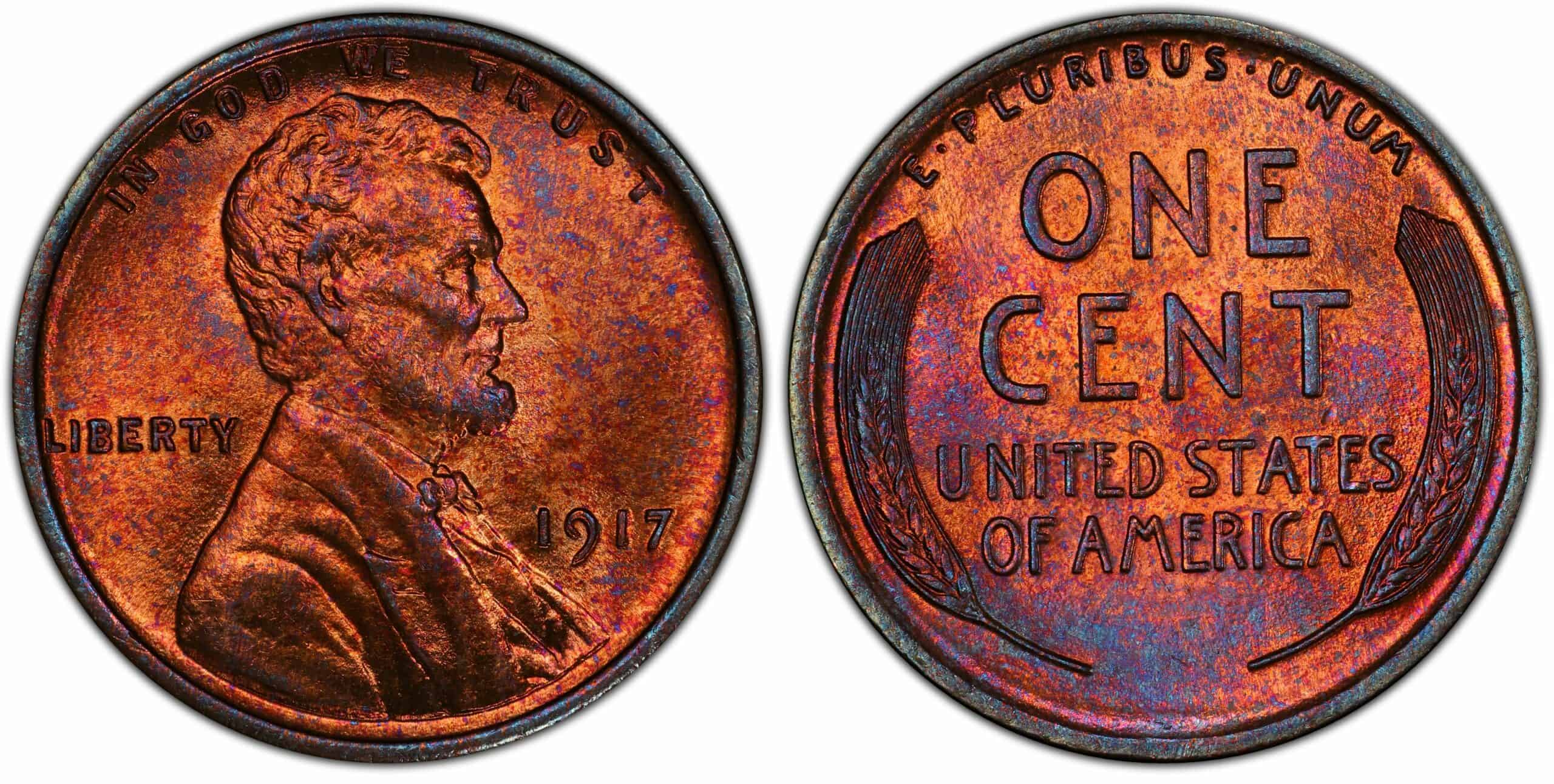
The double die obverse (DDO) error occurs when the die strikes the coins twice, resulting in doubled images and inscriptions. 1917 Wheat pennies, with DDO error, often display significant doubling on the date and phrase “IN GOD WE TRUST”.
Such coins can fetch very high prices in the market. As a fact, a 1917 Wheat penny in MS66 grade with DDO error can sell for as much as $27,000. Those in mint state 66 or above and with a Red (RD) patina can have a value of $100,000 or higher.
2. 1917 Wheat Penny Struck-through Error
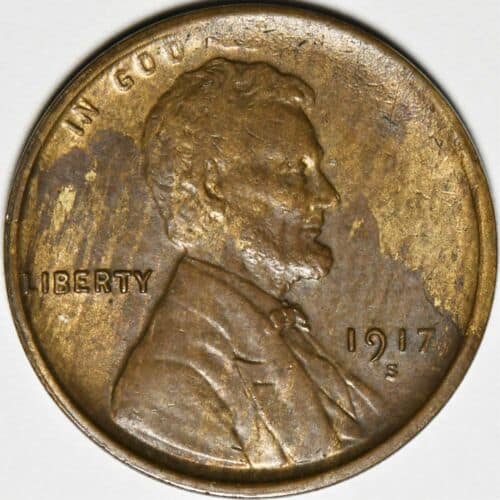
1917 pennies with struck-through errors usually feature impressions of items lodged between the die and the planchet during minting. While some impressions are easy to notice, some require a coin’s microscope. Either way, the uniqueness of the struck-through impression can raise the value of the 1917 penny for $1 to $1,000 +, irrespective of the grade or condition.
3. 1917 Wheat Penny Die Crack Error
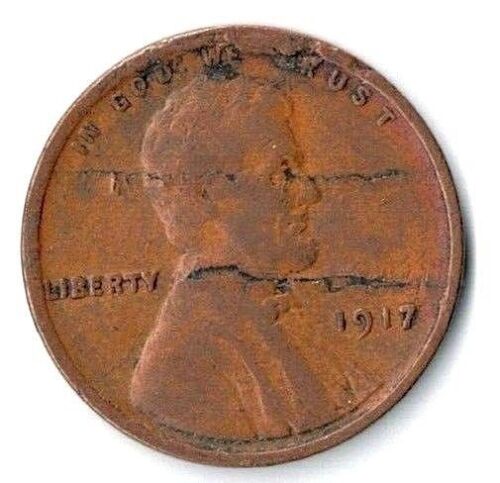
Another common 1917 Lincoln penny error is the die crack or die cud. Coins with these errors exhibit bumps or bulges on their surfaces. The errors result from cracks or damage to the dies. Pennies with this error can sell for as much as $150, depending on the grade.
1917 What Penny FAQs
How many wheat pennies were struck in 1917?
In 1917, three minting facilities stuck the Lincoln cent, including:
- Philadelphia mint: 196,426,785
- Denver mint: 55,120,000
- San Francisco mint: 32,620,000
In total, over 280 million wheat pennies got minted that year, and a majority entered circulation.
What makes the 1917 Penny Rare?
The Wheat penny became a dominant cent in 1917 when the US entered the WWI war. As a result, the coin holds significant historical significance. In addition, some 1917 pennies have unique coloration (BN, RB, and RD), mint marks, and errors. These factors make these coins valuable, especially in mint state.
Who designed the Lincoln Wheat Penny?
The designer behind the Lincoln wheat cent design is Victor David Brenner. He created the first design of the cent in 1909, and production began the same year. The first edition of the 1909 Wheat penny displayed the initials of the person who designed it – VDB – on the back. Even though the initials got removed in the subsequent wheat pennies series, in 1918, they reappeared.
